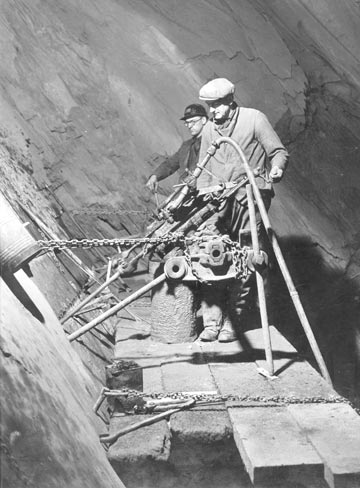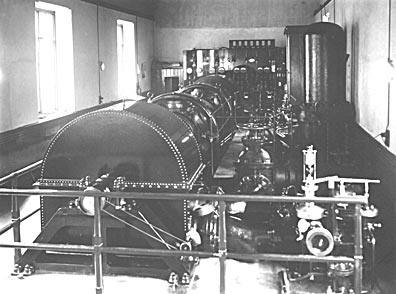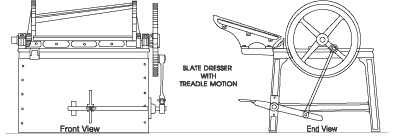Quarrying Techniques - Mechanisation:
Yesterday and Today
Water and Steam Power
Mechanical techniques appear to have been introduced as far
back as the 1820's. At Cilgwyn, for instance, horse
whimsies, for raising slates, and winches were in use by 1827. The
water balance was also introduced in 1829 to raise slate blocks
up a vertical shaft at Tal-y-sarn. Steam power was first used as
early as 1807 to keep Hafodlas Quarry free of water. Windmills
were not unknown either at this time. Steam took some time to
supplant the power of water itself as a source to drive
machinery. Steam power began to be used in some of the Ffestiniog
quarries by the 1850's and 1860's, even though some, like
Llechwedd Quarry, still had complicated workings with small and
large waterwheels still in use and no steam power whatsoever. The Nantlle Quarries were using steam by 1864, with the impressive
Holman Beam engine at Dorothea being installed in 1904. Candles
were used to light underground workings everywhere.
Electricity
 A very important
development happened at Llechwedd in 1890 when electricity was introduced at the
instigation of the manager, Warren Roberts, an engineer, and using waterpower to drive the
dynamos. Within a decade, other quarries in the same area had
followed suit. The Croesor Quarries also began using electricity
soon after 1901, not only to drive machinery but also a 30hp
electric mine locomotive in a main mining tunnel. A very important
development happened at Llechwedd in 1890 when electricity was introduced at the
instigation of the manager, Warren Roberts, an engineer, and using waterpower to drive the
dynamos. Within a decade, other quarries in the same area had
followed suit. The Croesor Quarries also began using electricity
soon after 1901, not only to drive machinery but also a 30hp
electric mine locomotive in a main mining tunnel.
Pneumatic Drills
However, the open quarries lagged behind in introducing modern
methods. Drilling was still carried out at Penrhyn in 1912, and
the following year saw the introduction of pneumatic drills. More
haulage gear was attached to many of the old gravity inclines as
well.
Petrol and diesel locomotives
The steam engines, introduced in the 1860's in the main, were also phased out
with petrol and diesel locomotives being used from the 1930's onwards.

|